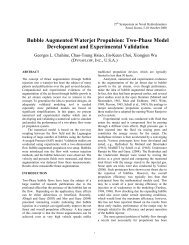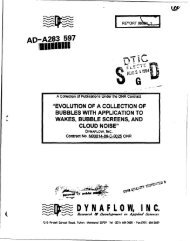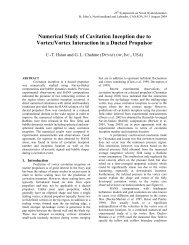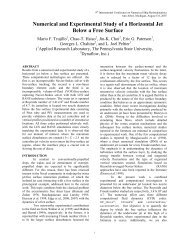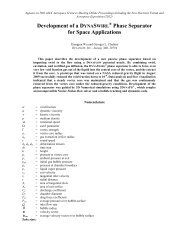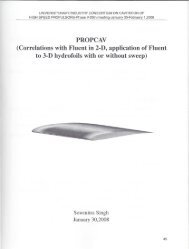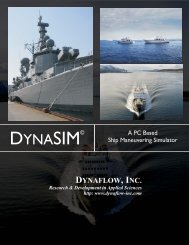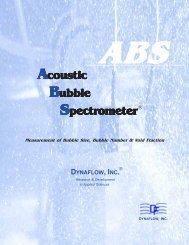Spherical Bubble Dynamics in a Bubbly Medium - Dynaflow, Inc.
Spherical Bubble Dynamics in a Bubbly Medium - Dynaflow, Inc.
Spherical Bubble Dynamics in a Bubbly Medium - Dynaflow, Inc.
You also want an ePaper? Increase the reach of your titles
YUMPU automatically turns print PDFs into web optimized ePapers that Google loves.
2012 Intl. Conf. on Numerical Methods <strong>in</strong> Multiphase Flows<br />
State College, PA, 12-14 June 2012<br />
<strong>Spherical</strong> <strong>Bubble</strong> <strong>Dynamics</strong> <strong>in</strong> a <strong>Bubbly</strong> <strong>Medium</strong><br />
J<strong>in</strong>gsen Ma, Sowmitra S<strong>in</strong>gh, Chao-Tsung Hsiao, J<strong>in</strong>-Keun Choi, Tiffany Fourmeau and<br />
Georges Chah<strong>in</strong>e<br />
DYNAFLOW, INC.<br />
10621-J Iron Bridge Road, Jessup, MD 20794<br />
Email: j<strong>in</strong>gsen@dynaflow-<strong>in</strong>c.com<br />
Tel: (301)604-3688<br />
ABSTRACT<br />
For applications <strong>in</strong>volv<strong>in</strong>g large bubble<br />
volume changes such as <strong>in</strong> cavitat<strong>in</strong>g flows or for<br />
shock and pressure wave propagation <strong>in</strong> a bubbly<br />
medium, the dynamics, relative motions,<br />
deformations, and <strong>in</strong>teraction of bubbles with the<br />
surround<strong>in</strong>g medium are essential and require<br />
accurate model<strong>in</strong>g. In this presentation, a twoway<br />
coupled Euler-Lagrange model is considered<br />
for a geometrically simple but numerically<br />
challeng<strong>in</strong>g configuration: A large spherical<br />
bubble (primary bubble) oscillat<strong>in</strong>g <strong>in</strong> a bubbly<br />
mixture of dispersed bubbles of much smaller<br />
sizes. The model treats the two-phase medium<br />
us<strong>in</strong>g a cont<strong>in</strong>uum model while the bubbles are<br />
considered <strong>in</strong> a Lagrangian fashion. For the<br />
primary bubble, the large amplitude motion<br />
dynamics is fully resolved by us<strong>in</strong>g a mov<strong>in</strong>g<br />
grid <strong>in</strong>terface track<strong>in</strong>g scheme. For each of the<br />
smaller bubbles, dynamics is modeled by<br />
utiliz<strong>in</strong>g a Surface Averaged Pressure (SAP)<br />
modified R-P Keller Herr<strong>in</strong>g equation, and the<br />
motion is tracked <strong>in</strong> a Lagrangian fashion. In<br />
addition, the flow field is simulated by directly<br />
solv<strong>in</strong>g the Navier-Stokes equations <strong>in</strong> an<br />
Eulerian fashion. The two-way coupl<strong>in</strong>g between<br />
the Eulerian fluid model and the Lagrangian<br />
discrete bubble model is realized through the<br />
modification to the local density field of the<br />
mixture due to the volume change and motion of<br />
the dispersed bubbles.<br />
The effect of the presence of the dispersed<br />
bubbles on the primary bubble dynamics, on the<br />
propagation of pressure waves <strong>in</strong> the medium,<br />
and on the distribution <strong>in</strong> space and time of the<br />
void fraction are <strong>in</strong>vestigated for various mixture<br />
properties, such as mean void fraction and bubble<br />
size and distribution.<br />
Primary <strong>Bubble</strong><br />
(Mov<strong>in</strong>g Grid Method)<br />
Dispersed <strong>Bubble</strong><br />
(SAP Model)<br />
Figure 1. Illustration of the problem of the dynamics of a<br />
primary spherical bubble <strong>in</strong> bubbly medium.
Figure 2. Variation of the primary bubble radius for different<br />
<strong>in</strong>itial void fractions obta<strong>in</strong>ed by the Euler-Lagrange model.<br />
The numerical simulations are compared to<br />
Gilmore bubble dynamics equation for the<br />
primary bubble. In the Gilmore analytical model<br />
the bubbly mixture surround<strong>in</strong>g the primary<br />
bubble is assumed to be a homogenous medium<br />
and an equation of state to describe the bubbly<br />
mixture account<strong>in</strong>g for changes <strong>in</strong> the medium<br />
properties <strong>in</strong> space and time. A comparison<br />
between the numerical and analytical models<br />
reveals the f<strong>in</strong>e differences that arise from<br />
account<strong>in</strong>g for the dynamics of the discrete<br />
bubbles. Overall, both models show that the<br />
surround<strong>in</strong>g bubbly medium absorbs the energy<br />
radiated from the primary bubble thereby<br />
damp<strong>in</strong>g the bubble oscillations and result<strong>in</strong>g <strong>in</strong><br />
important reduction <strong>in</strong> both its maximum radius<br />
and its period. These effects become more<br />
significant when the nom<strong>in</strong>al void fraction of the<br />
mixture <strong>in</strong>creases (Figure 2). Experimental<br />
observations conducted <strong>in</strong> parallel us<strong>in</strong>g spark<br />
generated bubbles <strong>in</strong> bubbly media are found to<br />
be <strong>in</strong> good qualitative agreement with the<br />
results.<br />
ACKNOWLEDGMNETS<br />
This work was conducted at DYNAFLOW,<br />
INC. (www.dynaflow-<strong>in</strong>c.com) and was supported<br />
by the Department of Energy under Phase II<br />
SBIR Program No. DE-FG02-07ER84839 and by<br />
the Office of Naval Research under contract No.<br />
N00014-08-C-0448 monitored by Dr. Ki-Han<br />
Kim.



